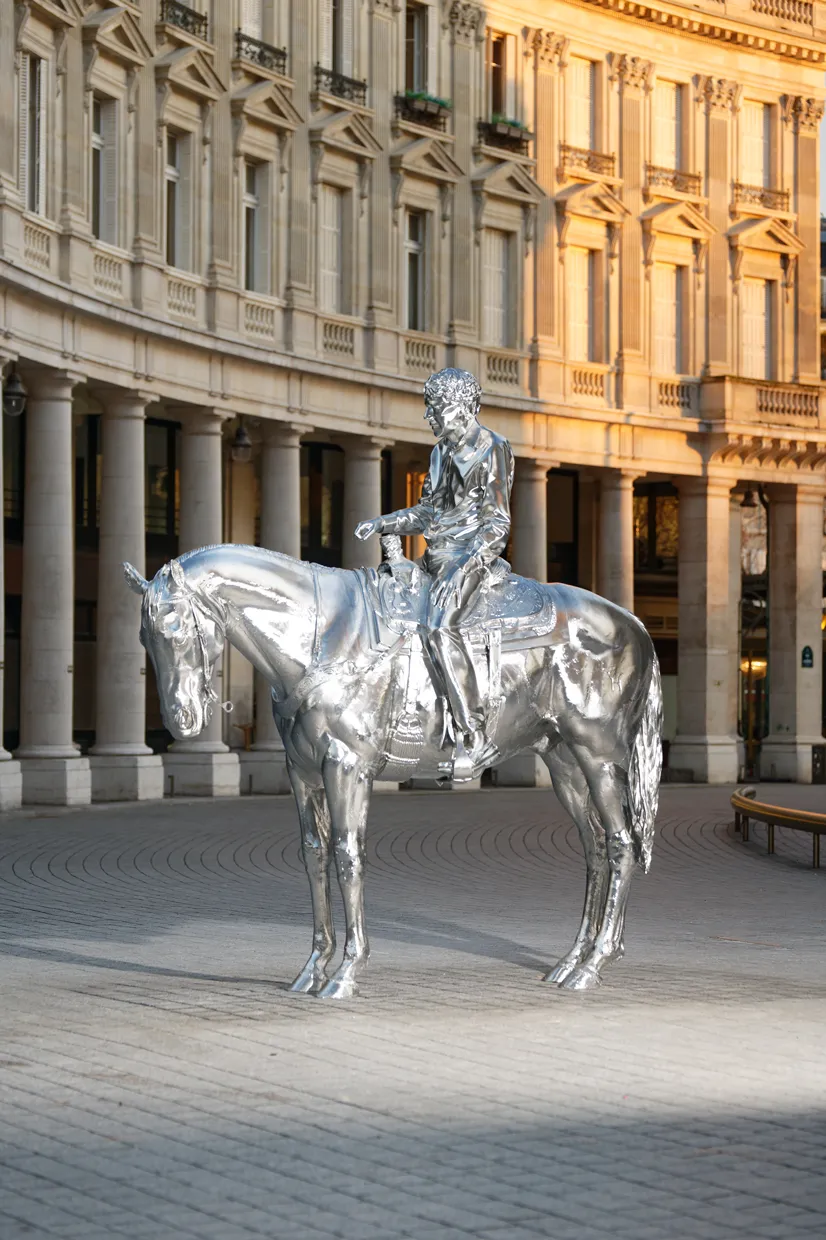
The installation of Horse and Rider
On the night of the 13th to the 14th of December, the sculpture entitled Horse and rider was installed on the Museum’s forecourt.
This work by Charles Ray announces the opening of the first large-scale exhibition devoted to the American artist in France.
As the sun rose over the forecourt of the Bourse de Commerce, passers-by could watch the installation of the artwork, by means of a crane, in the presence of the artist. This equestrian statue weighs approximately ten tons but seems to rest on the ground, as light as a feather, without a visible pedestal.
Horse and rider plays with the codes of the equestrian statue and the public monument
It represents the artist riding a horse. Horse and rider evokes the classical figure of the equestrian statue, a “canon” invented in antiquity, notably through the statue of Emperor Marcus Aurelius on the Capitoline Hill in Rome, and further developed during the Renaissance through honorific representations of condottiere (warlords), like Donatello’s Gattamelata in Padua and Verrochio’s statue of Colleone in Venice. As usual, Charles Ray makes use of the models to hand, and the easiest to find, is of course, himself. Paris too is punctuated by similar sculpted groups, representing saints and kings on horseback: from Bosio’s Louis XIV in the centre of the nearby Place des Victoires to Bernini’s Louis XIV in the Cour Napoléon of the Louvre, Lenot’s Henri IV erected in the middle of Pont Neuf, and the statue of Joan of Arc on the rue Castiglione, to name but a few.
Subverting a statuary associated with power and magnificence, Horse and rider inverses all of its codes, undermining in the process the manifesto of assurance and virility traditionally evoked by the genre. In place of a majestic, haughty figure in motion, the figure of the artist seated and hunched on his immobile steed, appears somewhat powerless: “I am not a rider and the horse knows it. I tried to sculpt my nervousness as well as that of the horse” (excerpt from the catalogue of the Kunstmuseum, Basel, 2014). And for good reason: the artist omitted to sculpt the reins, allowing the rider to steer the horse. This image conjures up another: that of a possible self-portrait of an artist, pictorial this time—Watteau’s portrait of Gilles, a disenchanted entertainer.
Horse and rider does not commemorate any battle, nor does it showcase its model. As is often the case with the artist, the aim is more to question a “type” in the history of sculpture, in order to better bear witness to its plastic value over time: “I see large archaic or classical sculptures as contemporary. They work too well to be discarded or forgotten, regardless of the original destination of the work.” Horse and rider, placed directly on the ground rather than a pedestal, interacts directly with the space and the city, in which the viewer or the public find themselves. Finally, the work bears a certain connection to the artist’s personal history: he spent his adolescence in a particularly strict military high school. There is also a connection to American history, whether a reference to patriotic sculpted groups, Hollywood films, children’s figurines, the Wild West, and of course, the legendary figure of the cowboy on horseback. This man on a horse evokes an extensive iconography and historical density to which the artist responds with the sheer weight of the work—almost ten tons.
Firmly embedded in space and in the multiple traditions of representation, here, the equestrian statue sees the opening of a new chapter in its history, where the superb gives way to the anti-hero: the modern-day Don Quixote.
“My sculptures form a circle on the second floor, and in front of the Bourse, we can find another portrait of the artist—myself—slumped in a Western-style saddle, resting on an equally tired mount. We’re both exhausted, but instead of being stuck up in the clouds on an imposing stone pedestal, we’re right on the ground, on the same level as the passers-by.”
Charles Ray
Extract from the essay "Twenty-six tons" in the exhibition catalog